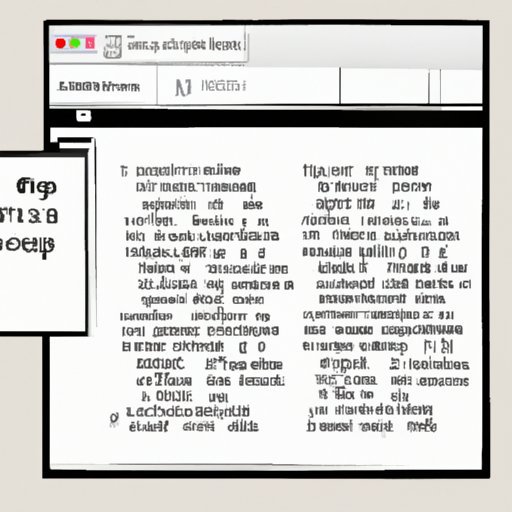Introduction
Screenshots are a vital tool for anyone who wants to capture a moment, show off an accomplishment, or explain a problem. If you use Windows, taking a screenshot is relatively easy, but there are actually several ways to do it. In this article, we’ll walk through the different methods for taking and enhancing your Windows screenshots.
Step-by-Step Guide for Taking a Screenshot on Windows
The most basic way to take a screenshot on a Windows computer is to use keyboard shortcuts. You can capture your full screen by pressing the “Print Screen” key or capture only the active window by pressing “Alt + Print Screen”. The screenshot is then saved to your clipboard, which you can then paste into an image editing program, such as Paint.
Another option is to use the Snipping Tool, which is available on most Windows operating systems. To open the Snipping Tool, go to the Start Menu, type “Snipping Tool” in the search bar, and select it from the list. From there, click “New” to begin your screenshot, and choose the area of the screen you want to capture. You can save your screenshot from there or use the markup tools to add annotations.
Exploring Different Screenshot Methods on Windows and Their Benefits
Taking full-screen screenshots is great for capturing an entire webpage, but sometimes you only want to capture specific sections. Partial screen screenshots are great for capturing specific parts of a document or webpage. You can take partial screenshots by using the Snipping Tool and selecting the area you want to capture.
Additionally, you can capture screenshots of specific windows, rather than the entire screen. To do this, click on the window you want to capture, and then press “Alt + Print Screen”. This will capture the active window and save it to your clipboard.
Windows Game Bar is another useful tool for taking screenshots while gaming. To access it, press “Windows + G”. From there, you can take screenshots, start and stop recording, and access your game’s audio settings.
Understanding the Various Screenshot Tools Available on Windows
The Snipping Tool is one of the most popular screenshot tools on Windows. It allows you to take screenshots of any shape and size, as well as add markup tools such as pens or highlighters. Windows 10 Screenshot Sketch and Draw is also a great tool for enhancing your screenshots. With this program, you can sketch and annotate directly on your screenshot before saving it.
There are also several third-party screenshot software options available, such as Greenshot and Lightshot. These programs offer customizable hotkeys and editing software that goes beyond basic markup tools.
Tips and Tricks for Enhancing Your Windows Screenshots
Adding annotations to your screenshots can help highlight important information. To do this, simply open the image in the Windows Snip & Sketch program, and use the “Draw” tool to add arrows, circles, or text.
You can also crop your screenshot to focus on a specific area using the Snip & Sketch program. Simply select “New” and then choose “Snip Now”. Once you’ve taken your screenshot, you can select the “Crop” tool to adjust the boundaries of your screenshot.
Additionally, adjusting the image quality can make a big difference in the final product. You can do this by opening the image in Paint and selecting “Resize”. From there, you can increase the image size and resolution.
Using Third-Party Software to Take Screenshots on Windows
There are several third-party software options available for taking and enhancing Windows screenshots. Greenshot offers customizable hotkeys and sharing options, while Lightshot provides image recognition and editing tools. Nimbus Screenshot is great for capturing video and scrolling web pages, and PicPick offers a wide range of editing and annotation tools.
Common Issues with Taking Screenshots on Windows and How to Fix Them
One common issue when taking screenshots on Windows is the file format. By default, Windows saves screenshots in the PNG format, which can take up a lot of space. To change the file format, simply open the Snipping Tool and go to “Options”. From there, you can change the default file type to JPG or GIF.
Another issue is when window previews don’t appear when taking partial screenshots. To fix this, click on the window you want to capture and wait a few seconds before pressing “Alt + Print Screen”.
Finally, if you’re having trouble with screenshots not saving accurately, try restarting your computer or updating your graphics card driver.
Conclusion
In conclusion, taking a screenshot on Windows is an easy process, but there are several methods and tools available to enhance your screenshots. Whether you’re annotating an image or capturing a video, there’s a tool out there that can help. By following the step-by-step guide and utilizing the tips and tricks outlined in this article, you can improve the quality of your Windows screenshots and make the most out of this important feature.
